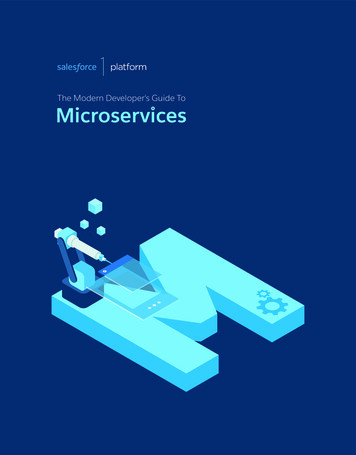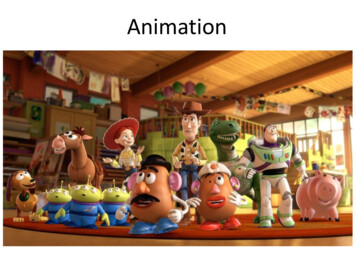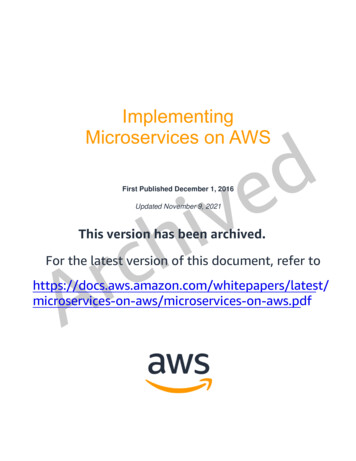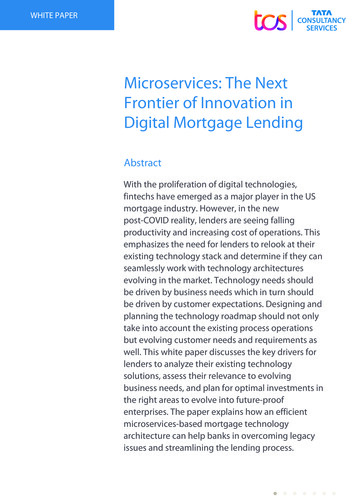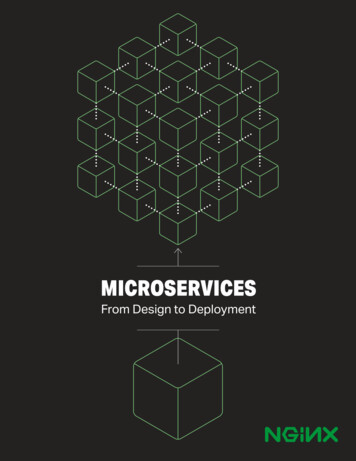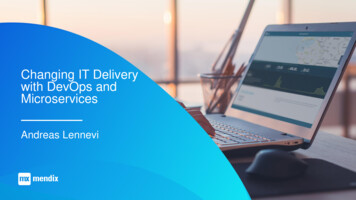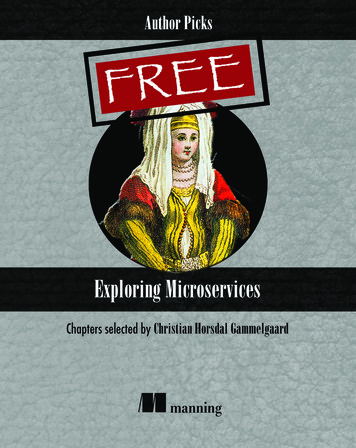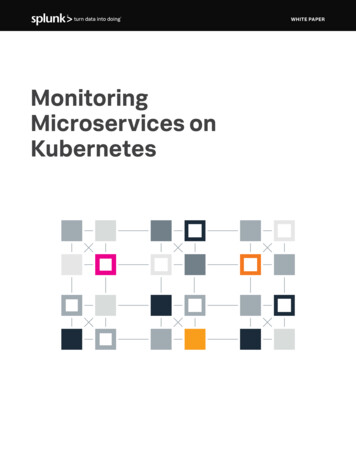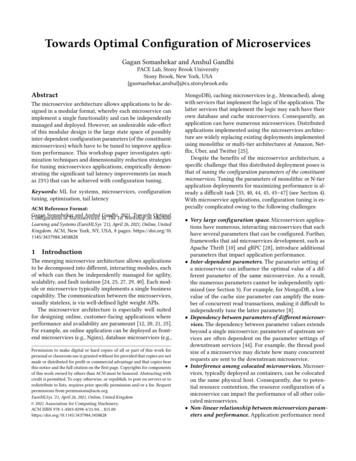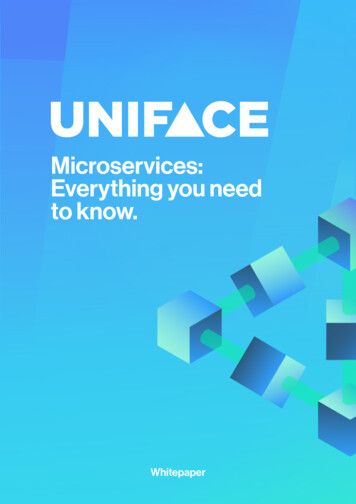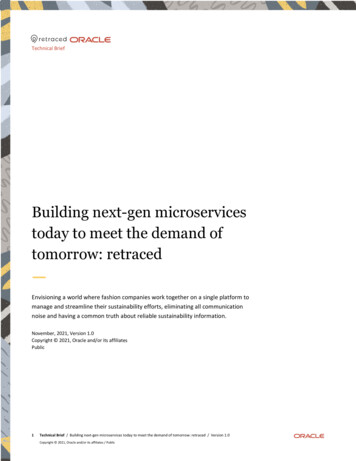
Transcription
Technical BriefBuilding next-gen microservicestoday to meet the demand oftomorrow: retracedEnvisioning a world where fashion companies work together on a single platform tomanage and streamline their sustainability efforts, eliminating all communicationnoise and having a common truth about reliable sustainability information.November, 2021, Version 1.0Copyright 2021, Oracle and/or its affiliatesPublic1Technical Brief / Building next-gen microservices today to meet the demand of tomorrow: retraced / Version 1.0Copyright 2021, Oracle and/or its affiliates / Public
Table of contentsVision3retraced: The sustainability management platform4Building a globally accessible and data flexible infrastructure5Networking flow of a client request6Ensure authenticity of raw material origin with traceability7Technical challenges and architectural decisions9Microservices9Monolithic database9Database: JSON vs relational10Database connection pools with microservices10Cloud first and only10Why Oracle?10References11List of imagesImage 1. The sustainability management platform where impact meets2efficiency.3Image 2. The eleven Sustainable Development Goals badges are awardedautomatically based on the certifications and other proofs of sustainability in aproduct supply chain. Example: rache-benito4Image 3. A supplier assessment example in the retraced web back-office. Thisdepicts a typical overview of the progress of the suppliers answering their ownquestionnaires and filling out requirements.5Image 4. Overview of interfaces to the retraced API.6Image 5. The retraced architecture overview.7Image 6. Typical flow to ensure authenticity of collected data and build on-the-flyfast retrievable product history.8Technical Brief / Building next-gen microservices today to meet the demand of tomorrow: retraced / Version 1.0Copyright 2021, Oracle and/or its affiliates / Public
VisionRetraced envisions a world where fashion companies work together on a single platformto manage and streamline their sustainability efforts, eliminating all communicationnoise and having a common truth about reliable sustainability information; acomprehensive and unifying platform that connects all the parties in the complex fashionsupply chain. Primarily, such a solution demands 24/7 availability, web and smartphoneaccess, and interoperability with existing on-prem and cloud solutions. In addition, itmust be built with an open API and with the potential to scale to the demand given bythe seasonal nature of production. This paper aims to elaborate on the decisions made byretraced about the utilization of microservices and the different layers of thearchitecture, to clarify what these systems are solving, and explain how together theyprovide on-demand scalability while being fast and extensible at the same time.3Technical Brief / Building next-gen microservices today to meet the demand of tomorrow: retraced / Version 1.0Copyright 2021, Oracle and/or its affiliates / PublicImage 1. The sustainability managementplatform where impact meets efficiency.
retraced: The sustainability management platformretraced is a sustainability management platform for the fashion industry. Its goal is tomake sustainable information management easy by providing easy means to collect allrelevant information, process it and then communicate it with all the stakeholders acrossthe supply chain. A standout service offered by the retraced platform is communicationof sustainability information also to the end-consumer in a straightforward and easy-tounderstand manner and backed by verifiable proofs. Indeed, making the customer awareof one’s sustainability efforts is a potent way to properly communicate the brand imagein an understandable and effective way and further increase brand awareness and brandrecognition.Retraced is driven by an unyielding commitment to quality and transparency; printingcertification labels on garments does not empower consumers to make educatedpurchasing decisions, nor does it appraise them of the true history of the product itself.Thus, a badge-based system of eleven badges was developed, indicating a product’svarious sustainability metrics. These badges are based on eleven of the UN SustainableDevelopment Goals [1] and are derived automatically from the information availableabout the product such as the supply chain chronology and the different stages it wentthrough, from harvesting the raw materials all the way to the finished garment. Theplatform provides visibility into the entire supply chain, including all companies that havecontributed to the final product in one way or the other. Each individual company mayalso have certifications like Global Organic Textile Standard [2], audits like from Elevate[3] or memberships like the Fair Wear Foundation [4] membership. Additionally, allproduct-specific documents can be stored on the platform as well, such as lab proofs ofleather components for the use of non-hazardous chemicals. All this information isprocessed to automatically generate the badges for a given product. A client can evenchoose to link its online store to the retraced system and display the badges directly oneach product’s store page, providing the customers an always up-to-date sustainabilitystatus.“With retraced ourindividual efforts inthis direction becomepart of a biggermovement which hasthe potential to setnew standards andmaybe one day forceeven bigger players totake responsibility fortheir value chains andthe people involved.”Carolin HoferCo-CEOJyoti – Fair WorksSustainable Development GoalsAre the foundation for the missionat retraced. They comprise all areasof sustainability and clear targets ofall nations to foster sustainability inthose areas.https://sdgs.un.org/goalsImage 2. The eleven Sustainable Development Goals badges are awarded automatically based on the certifications andother proofs of sustainability in a product supply chain.Example: arache-benitoTo collect all proofs in a supply chain and trace garments back to raw materials, i.e.,down to the farm level, the system has been engineered to allow every party to invite thenext known parties that they work with to the platform as well. Each individual party ismaintaining its own profile and can populate it with the relevant sustainabilityinformation. If one party decides not to participate, other network members can chooseto collaborate and keep the non-participating party’s sustainability profile up to date.Based on this network, each tier in a supply chain is usually also evaluating the next tierthrough a preset or bespoke sustainability assessment. This assessment is essentially a4Technical Brief / Building next-gen microservices today to meet the demand of tomorrow: retraced / Version 1.0Copyright 2021, Oracle and/or its affiliates / Public
questionnaire about common sustainability aspects, like water usage, energyconsumption, certifications, etc. This gives each platform user the possibility to assess itspartner network in accordance with its own sustainability requirements. For example, acompany that requires all its suppliers to have a carbon offsetting program in place caneasily verify that by creating a Supplier Assessment for its network.Image 3. A supplier assessment example in the retraced web back-office. This depicts a typical overview of the progressof the suppliers answering their own questionnaires and filling out requirements.This assessment and the network management functionality, plus all the certifications,audits, and extensive document management make retraced a comprehensivesustainability management platform.Having now understood what the platform shall achieve, the technical architecture andinfrastructure will be covered in depth.Building a globally accessible and data flexible infrastructureTo decide on an architecture, first, the interfaces of the technology customers will wantto use have to be identified. To this end, two types of clients were identified; controlledclients, which are applications that retraced is providing and uncontrolled clients, whichare systems connecting directly to the retraced API, like the ERP solutions of customers.The following is a list of client technologies: iOS and Android app for businessesCustomers like farmers cannot be expected to own a laptop and use the desktop/web version of the platform, but given the growing level of smartphone penetrationin the world, they can be expected to be able to access the platform through amobile app. In addition, a smartphone-native app provides system capabilities like aphone camera for product QR code scanning and push notifications. iOS and Android app for consumersOriginally, this app was targeted at consumers to scan for Near Field Communication(NFC) identifiers which can be hidden inside buttons or embedded within shoe soles.A mobile app was the only feasible way to provide Near Field Communication (NFC)interaction with a satisfactory user experience. However, because NFC tags can behard for consumers to locate and scan, this idea was dropped and as of today, theconsumer app has been marked as deprecated with the NFC tagging neitheradvertised nor advised any more.5Technical Brief / Building next-gen microservices today to meet the demand of tomorrow: retraced / Version 1.0Copyright 2021, Oracle and/or its affiliates / Public
Platform websiteA cloud-based frontend providing easy access to the complete suite of the retracedservice offerings. Web shop componentsThese are small web components which can be embedded in any website to displaysustainability badges of products. Adding the client shop’s host URL and productShelf Keeping Unit number (SKU; an internal product identifier used for warehousemanagement) into the retraced platform will be automatically represented as cards,icons, or any other visualization of the eleven badges. retraced also offers one-clickintegrations developed for Shopify, Prestashop, Shopware and WooCommerce,which simplify and automate this process.Web componentsWeb components provide amanipulation safe and sandboxedshadow DOM. They are the base forGoogle’s Amplified Mobile Pages(amp.dev). They use Web Workersto parallelize browser resourcecapacity.Image 4. Overview of interfaces to the retraced API.At the heart of the retraced architecture lies a blockchain network – a Hyperledger Fabricnetwork. Providing a tamper-proof chronological log of all noteworthy events, it allowsfor easy and trusted verification of certifications by the relevant authorities later. Thisaspect is critical and necessary since most certification authorities do not provide a publicAPI for certificate verification and hence only with active participation in a blockchainnetwork can the validity of a certificate be ascertained.Networking flow of a client requestWhen a client issues a request, it is bundled into a single access point. This reducesexposure and simplifies development as regards access security. This is the retraced API.Before even reaching the API, a network call must be DNS-resolved for api.retraced.co tothe “A” record of the load balancer IP within the Oracle Cloud Infrastructure. The call isthen directed towards that load balancer, which in turn forwards it to one of thecompute instances that are running the Kubernetes cluster. Kubernetes veils thedeployment complexities of the microservices and abstracts the process of a requestarriving at one of the compute instances.Inside Kubernetes, ingress rules have been set up that define how traffic must beforwarded within Kubernetes. The rules are simple: if traffic arrives at api.retraced.co,forward it to one of the running API containers.That’s it!There is no need to tell Kubernetes how to distribute the traffic internally; it does thatautomatically. Of course, one can always define everything for maximum customization,however such bespoke configuration is seldom needed.6Technical Brief / Building next-gen microservices today to meet the demand of tomorrow: retraced / Version 1.0Copyright 2021, Oracle and/or its affiliates / PublicMicroservicesMicroservices are tiny programswhich are focused on a specifictechnical use case like emailsending, SMS sending, webanalytics accumulation or others.They became very popular withDocker and Kubernetes aseverything can be quicklydockerized and a lot of Dockercontainers run in parallel handledby Kubernetes as “containerorchestration system”. Thus,Kubernetes made microservicesfinally easily accessible for everydeveloper.
KubernetesIs the orchestration of Dockercontainers over a flexible amountof compute instances. Kubernetesprovides a default networkingsetup on top of a node cluster ofcompute instances. One only mustdefine the container which shouldbe running and how manyinstances of those, and Kuberneteswill take care to distribute themautomatically and equally over allnodes.Image 5. The retraced architecture overview.It should be mentioned that despite this setup, any container within Kubernetes can stillmake calls to the public internet.Ensure authenticity of raw material origin with traceabilityA core functionality for sustainability management is product traceability. Traceabilitymeans that all companies in a supply chain can populate their own relevant data to provethe transfer of goods and the system can trace these transfers all the way to their originor final garment. Besides their receipt and shipments, most clients of retraced go even astep further and trace their in-house production processes. This in-house tracing is theenabler for full end-to-end traceability from receipt of raw materials to shippingintermediate products out. The combination of all transfers of goods between companiesand the in-house tracing within the companies themselves is the powerful combinationenabling farm to garment traceability.A major architectural decision for the retraced platform was the blockchain platform toensure tamper-proof audit logs and the possibility of decentralization of data validation.On the one hand, a tamper-proof system is an inevitable requirement when handlingcompliance information. On the other hand, a blockchain platform enables easy futureparticipation of other companies in the retraced solution as part of the data validationprocess. If a company decides to participate at a later stage, it will just become anotherparticipant in an already existing blockchain with no need for manual data integration.The drawback of the blockchain platform (Hyperledger Fabric in this case) is that asynchronous write takes several seconds to fully complete, including a blockconfirmation, in just a very simplistic test setup. This delay is not acceptable for typicaluser interfaces. Thus, this forced the creation of a gateway service to handle temporaryvalidation of data.Another user interaction is the quick lookup of the whole chain of transfers for a singleproduct. The traceability chain cannot be built up on the fly in a user-acceptabletimeframe, as it requires a very complicated recursive query covering multiple technicalassets of shipment, receipt, warehousing, in-house tracing, transportation and so on.Hence, it was clear that a runtime update of a traceability snapshot is needed.7Technical Brief / Building next-gen microservices today to meet the demand of tomorrow: retraced / Version 1.0Copyright 2021, Oracle and/or its affiliates / PublicSupply chain mapping vs tracingMapping a supply chain is justbuilding an assumption wheregoods were sourced from the viewof the final product. It does notinvolve any of the other parties.Whereas traceability ensures thateach party in the chain contributesto themselves relevant proofs ofthe transfer of goods. Thus,traceability makes the proof oforigin very strong as cheatingwould require all parties to cheat.
With this understanding, Image 6 depicts the flow of information in the technicalinfrastructure.Image 6. Typical flow to ensure authenticity of collected data and build on-the-fly fast retrievable product history.All requests start at the API service for authentication and authorization (1). There, allsystem critical data is stored synchronously in the Autonomous Transaction Processingcloud service. If data must be submitted to the blockchain for verification and auditpurposes – not all data must go through this like, for example, analytics data – the datapoint is persisted into the Autonomous Transaction Processing cloud service but markedas “temporarily accepted and pending blockchain verification” (2).As soon as the API has finished the business-critical operations like authentication andauthorization checks as well as the actual operations of the endpoint like writing to users,companies, or orders tables, the (temporarily correct) result is returned to the caller.Additionally, messages are dispatched to the relevant microservices to be furtherdigested. For the update of a shipment, for example, a message is dispatched to theblockchain as well as the tracing service (3a), (3b).The tracing service picks up the message (3a) and extends the information for futurelookups to be able to quickly retrieve the shipment operation and all previous operationsthat occurred on the goods of a shipment. As new snapshots are built over time, previousalready existing snapshots can be used to eliminate any on-the-fly calculation and speedup the process by 100X and more. Likewise, when tracing information for a shipment isrequested, the tracing snapshot is already there ready to be returned to a callerimmediately.Meanwhile, the blockchain service executes the call to the blockchain platform and waitsfor the result (4). Here, waiting for the synchronous answer of the blockchain platform isnot a concern because the (temporarily correct) result has already been returned. If thereare more messages coming onto the message broker than the blockchain service candigest, another instance of the service is created. Once the call returns from theblockchain platform, the blockchain service updates the asset marked as “temporarilyaccepted and pending blockchain verification” in the Autonomous Transaction Processingcloud service as fully completed (5).8Technical Brief / Building next-gen microservices today to meet the demand of tomorrow: retraced / Version 1.0Copyright 2021, Oracle and/or its affiliates / Public
The neat addition in the setup is the Autonomous Data Warehouse cloud service, which islinked directly as a rich history database to the blockchain platform (6). This is a uniqueattribute of the Oracle Cloud with the purpose of being able to work with the data on theblockchain. As mentioned earlier, the blockchain platform interaction is quite slow as itrequires execution of a smart contract every time it is interacted with. The rich historydatabase connection will transmit every newly created block on the blockchain directlyinto the Autonomous Data Warehouse cloud service. This allows business intelligenceand other analytics to be executed on blockchain data efficiently and via SQL.Technical challenges and architectural decisionsMicroservicesInitially, a monolithic approach was adopted for the API service. However, this patternsoon revealed its caveats. For instance, a single call to the underlying blockchain servicetook almost 7 seconds for the full success response. Luckily, this circumstance wasidentified early on, and a course correction was made to throttle and delay the finalresponse from the blockchain to the user, as it turned out to be not mission critical. Adecision was made to instead enqueue messages on a message bus and process theseasynchronously. This netted two benefits: (1) throttled calls to the blockchain service andthe little compute power required for this and, (2) decoupled logic of handling complexdata processing in another microservice.Since then, new microservices have been developed for each specialized task:Notifications, CRON jobs, message posting, email sending, analytics, data aggregation,and many more.Monolithic databaseA consideration of microservices is that each service should use its own database to beflexible and scalable. Otherwise, notwithstanding the benefits of having microservices inplace, the bottleneck arising from the underlying monolithic database will immediatelymaterialize.However, this is remedied with the Oracle Autonomous Database, due to the enterprisegrade Autonomous Transaction Processing and Autonomous Data Warehouse CloudServices offered. The Autonomous Database supports database clustering out of the boxand can be scaled to a great extent and fully online, alleviating the need for separatedatabase instances.Furthermore, each microservice is allowed to read from every table, but is only allowedto write to its own ones. The reason for the latter is simple: it would never be clear whichmicroservice was responsible for the data in a table. It is not about dead locking, nor dirtywrites and reads. Oracle Database is amazingly smart enough not to cause any of theseissues unlike other databases. But data could, of course, still be overwritten by othermicroservices without executing the necessary business rules. Hence, to avoid such asituation, microservices only have write privileges on their owned tables, as mentionedabove. A benefit, however, of allowing read access from all tables is that no further APIcalls nor data transfer between the microservices is necessary to access a piece ofinformation. Despite what conventional wisdom in the microservices space says, this is ofgreat benefit to the retraced system and architecture.9Technical Brief / Building next-gen microservices today to meet the demand of tomorrow: retraced / Version 1.0Copyright 2021, Oracle and/or its affiliates / Public
Database: JSON vs relationalNeither of the two data formats, JSON or relational, has been fully adopted throughoutthe system. Instead, the one format that is best suited for a task is used. Thus, JSONmight be used for answers of questionnaire builders, and relational when all data can beclearly identified, and fast access, generic is needed. Since the Oracle AutonomousDatabase provides easy JSON dot notation and JSON generation, easy future migrationpossibilities remain open in both directions.Database connection pools with microservicesThe database connections took some time to optimize and set properly for theconnection pool in each NodeJS process. An investigation revealed that a consequence ofsetting the connection pool max size to the NodeJS environment variableUV THREADPOOL SIZE necessitated setting the latter to the amount of virtual CPU coresavailable. For example, on a 4 core Intel machine with Hyperthreading enabled, it wouldbe set to 8. This will allow the Node-oracledb driver to utilize all available cores in parallelto the best extent. Due to the low number of cores, pool min size was set to pool maxsize (and no increment size) to keep the connection count constant.The downside of this approach is that every new container will immediately occupy 8connections to the database. With 10 services at the time of writing this paper, and thetotal of services and replicas being 30, there are 30 * 16 (8 hyper-thread CPU compute inproduction cluster), totaling 480 connections.Although there are approaches to handle the pool on the database side (DatabaseResident Connection Pooling [5]), it is not trivial to setup as it would require a preinitialization on the database side. Hence, it is recommended to increase the Oracle-CPUcount for the database to prevent any performance bottleneck here.Cloud first and onlyAt retraced, all services are generally run as cloud services and in the best case, asmanaged or autonomous services. This principle is to keep the engineering departmentlean and focused on true value creation through product enhancements, rather thanhardware and system maintenance.The only drawback to this approach is the more complex replication required for a localdevelopment setup. However, this is mitigated to a great extent with the use of Dockercontainers.Why Oracle?Ever since the genesis of retraced back in 2019, the need for an extensive techinfrastructure was present. The aim was to stay lean with the available developmentresources and financial funds. Given these constraints, Oracle stood out as thefrontrunner for a cloud blockchain solution, as besides IBM it was the only other cloudprovider with a managed blockchain service. As such, and after a successful application tothe Oracle for Start-ups program [6], the retraced journey went full steam ahead.The partnership with Oracle started with immediate effect and a hackathon with severalOracle members was held in Duesseldorf, Germany. Some members even came fromIreland! It was a highly potent session with solution architects from all areas helping usidentify the tools and the best setup within the Oracle Cloud for the retraced platform.10 Technical Brief / Building next-gen microservices today to meet the demand of tomorrow: retraced / Version 1.0Copyright 2021, Oracle and/or its affiliates / PublicSQL JSON dot notationWhen running a database query,Oracle offers easy dot notationaccess to JSON data when using atable alias in the query and thecolumn has an IS JSON constraint.Thus, the following is valid SQLretrieving the “latitude” attributefrom a JSON document:SELECT u.location.latitudeFROM users u;
Besides the architectural help, Oracle has been very keen to introduce the retracedphilosophy to many circles. It started with an invitation to Oracle Open World in SanFrancisco where retraced co-founder Lukas Pünder was given a chance to speak [7] andother events like the recent Oracle Cloud Infrastructure Customer Summit where he wasalso a featured speaker [8].This forthcoming and helpful attitude of Oracle has allowed retraced to constantlyinnovate and stay ahead with the latest technological advancements.References[1] https://sdgs.un.org/goals[2] https://global-standard.org[3] https://www.elevatelimited.com[4] https://www.fairwear.org[5] l#drcp[6] https://www.oracle.com/startup/[7] for-blockchain-at-openworld-2019[8] https://videohub.oracle.com/media/Oracle Cloud Infrastructure Community Summit/1 1737bx2hConnect with usCall 1.800.ORACLE1 or visit oracle.com. Outside North America, find your local office at: acleCopyright 2021, Oracle and/or its affiliates. All rights reserved. This document is provided forinformation purposes only, and the contents hereof are subject to change without notice. Thisdocument is not warranted to be error-free, nor subject to any other warranties or conditions,whether expressed orally or implied in law, including implied warranties and conditions ofmerchantability or fitness for a particular purpose. We specifically disclaim any liability withrespect to this document, and no contractual obligations are formed either directly or indirectlyby this document. This document may not be reproduced or transmitted in any form or by anymeans, electronic or mechanical, for any purpose, without our prior written permission.Author: Peter Merkert, Co-Founder and CTO, retracedtwitter.com/oracleThis device has not been authorized as required by the rules of the Federal Communications Commission.This device is not, and may not be, offered for sale or lease, or sold or leased, until authorization isobtained.Oracle and Java are registered trademarks of Oracle and/or its affiliates. Other names may be trademarksof their respective owners.Intel and Intel Xeon are trademarks or registered trademarks of Intel Corporation. All SPARC trademarksare used under license and are trademarks or registered trademarks of SPARC International, Inc. AMD,Opteron, the AMD logo, and the AMD Opteron logo are trademarks or registered trademarks of AdvancedMicro Devices. UNIX is a registered trademark of The Open Group. 0120Co-Author: Gerald Venzl, Distinguished Product Manager, Oracle11 Technical Brief / Building next-gen microservices today to meet the demand of tomorrow: retraced / Version 1.0Copyright 2021, Oracle and/or its affiliates / Public
Microservices Microservices are tiny programs which are focused on a specific technical use case like email sending, SMS sending, web analytics accumulation or others. They became very popular with Docker and Kubernetes as everything can be quickly dockerized and a lot of Docker
